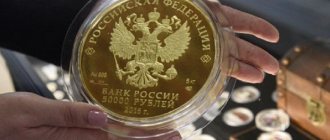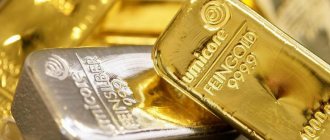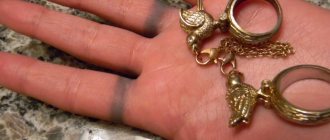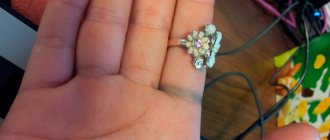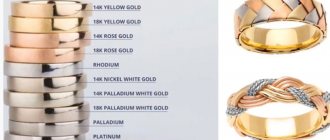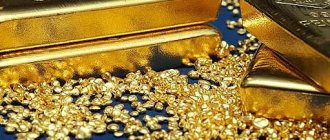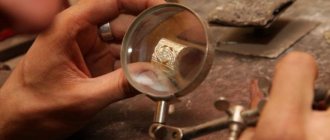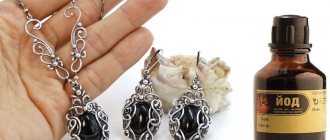1. History
1.1. origin of name
Proto-Slavic *zolto
(Russian
gold
, Old Slavic gold, Polish
złoto
) related to lit.
geltonas "yellow", Latvian. zelts "gold, golden"; with different vocalism: goth. gulþ
, German
gold
, English
gold
;
further Skt. hiraṇyam, Avest. zaranya, Osset. zærījnæ
"gold", also Skt.
hari "yellow, golden, greenish", from the Proto-Indo-European root *ǵʰel- "yellow, green, bright". Hence the names of the colors: yellow
,
green
.
Physical properties
Pure gold is a soft yellow metal. The reddish hue of some gold products, such as coins, is given by impurities of other metals, in particular copper. In thin films, gold shows through green. Gold has exceptionally high thermal conductivity and low electrical resistance.
Gold is a very heavy metal: the density of pure gold is 19,621 kg/m³ (a ball of pure gold with a diameter of 46 mm has a mass of 1 kg).
Among metals it ranks sixth in density: after osmium, iridium, rhenium, platinum and plutonium. The high density of gold makes it easier to mine. The simplest technological processes, such as washing at sluices, can provide a very high degree of gold recovery from the washed rock.
Gold is a very soft metal: hardness on the Mohs scale is ~2.5 (comparable to the hardness of a fingernail), on the Brinell scale 220-250 MPa.
Gold is also highly ductile: it can be forged into sheets up to ~0.1 µm thick (gold leaf); With such a thickness, gold is translucent and in reflected light has a yellow color, in transmitted light it is colored bluish-greenish, complementary to yellow. Gold can be drawn into wire with a linear density of up to 500 m/g.
26 pages, 12911 words
Scattered metals
... deposits using bacteria (see Bacterial leaching). Application Currency metals Retains the functions of currency metals, mainly gold (see Money). Silver was previously actively used as money, but...
Chemical properties
Gold is the most inert metal, standing in the series of stresses to the right of all other metals; under normal conditions, it does not interact with most acids and does not form oxides, due to which it was classified as a noble metal, in contrast to ordinary metals, which are easily destroyed by the environment. Then the ability of aqua regia to dissolve gold was discovered, which shook confidence in its inertness.
The most stable oxidation state of gold in compounds is +3; in this oxidation state, it easily forms stable flat square complexes [AuX4]− with singly charged anions (F−, Cl−, CN−). Compounds with the oxidation state +1, which give linear [AuX2]− complexes, are also relatively stable. For a long time it was believed that +3 is the highest possible oxidation state of gold, however, using krypton difluoride, it was possible to obtain Au+5 compounds (AuF5 fluoride, salts of the [AuF6]− complex).
Gold(V) compounds are stable only with fluorine and are strong oxidizing agents.
The oxidation state +2 is not typical for gold; in substances in which it is formally equal to 2, half of the gold is usually oxidized to +1, and half to +3, for example, the correct ionic formula of gold(II) sulfate AuSO 4 is not Au2+ (SO4 )2− , and Au1+ Au3+ (SO4 )2−2 . Recently, complexes have been discovered in which gold still has an oxidation state of +2.
There are gold compounds with an oxidation state of −1. For example, CsAu (cesium auride) Na 3 Au (sodium auride)[3]. These compounds are called Aurids.
Of the pure acids, gold dissolves only in hot concentrated selenic acid:
2Au + 6H 2 SeO4 = Au2 (SeO4 )3 + 3H2 SeO3 + 3H2 O
Gold reacts relatively easily with oxygen and other oxidizing agents with the participation of complexing agents. Thus, in aqueous solutions of cyanides with access to oxygen, gold dissolves, forming cyanoaurates:
4Au + 8CN− + 2H2 O + O2 → 4[Au(CN)2 ]− + 4 OH−
Cyanoaurates are easily reduced to pure gold:
2Na[Au(CN) 2 ] + Zn = Na2 [Zn(CN)4 ] + 2Au
In the case of a reaction with chlorine, the possibility of complex formation also significantly facilitates the reaction: if gold reacts with dry chlorine at ~200 °C to form gold(III) chloride, then in a concentrated aqueous solution of hydrochloric and nitric acids (regia vodka) gold dissolves to form chloraurate -ion already at room temperature:
2Au + 3Cl 2 + 2Cl− → 2[AuCl4 ]−
Gold easily reacts with liquid bromine and its solutions in water and organic solvents, giving tribromide AuBr 3[4].
8 pages, 3637 words
Gold deposit
...gold increases. During the oxidation of sulfide ores containing fine gold, the latter can dissolve and migrate. Such phenomena have been well studied in copper-pyrite and pyrite-polymetallic deposits of the Urals and Central Kazakhstan. In the oxidation zone... form. Organic compounds play a major role in this. Some of the gold leached from rocks and endogenous ores...
Gold reacts with fluorine in the temperature range 300−400 °C; at lower temperatures the reaction does not occur, and at higher temperatures gold fluorides decompose.
Gold also dissolves in mercury, essentially forming a low-melting alloy (amalgam) containing intermetallic compounds.
There are organogold compounds (for example, diethylgold bromide).
3.1. Physiological effects
Some gold compounds are toxic and accumulate in the kidneys, liver, spleen and hypothalamus, which can lead to organic diseases and dermatitis, stomatitis, thrombocytopenia. Organic gold compounds (preparations crizanol and auranofin) are used in medicine in the treatment of autoimmune diseases, in particular rheumatoid arthritis.
Geochemistry of gold
The gold content in the earth's crust is very low - 0.5÷5 μg/kg [5][6], but deposits and areas sharply enriched in the metal are very numerous. Gold is also found in water. 1 liter of both sea and river water carries approximately 4 × 10−9 g of gold, which corresponds to 4 kilograms of gold in 1 cubic kilometer of water.
Gold deposits occur predominantly in areas of granitoid development; a small number of them are associated with basic and ultrabasic rocks. Gold forms industrial concentrations in post-magmatic, mainly hydrothermal, deposits. Under exogenous conditions, visible gold is a very stable element and easily accumulates in placers. However, submicroscopic gold, which is part of sulfides, when oxidized, acquires the ability to migrate in the oxidation zone. As a result, gold sometimes accumulates in the zone of secondary sulfide enrichment, but its maximum concentrations are associated with accumulation in the oxidation zone, where it associates with hydroxides of iron and manganese. Migration of gold in the oxidation zone of sulfide deposits occurs in the form of bromide and iodide compounds in ionic form. Some scientists allow the dissolution and transfer of gold with ferric oxide sulfate or in the form of a suspension suspension.
There are 15 gold-containing minerals known in nature: native gold with admixtures of silver, copper, etc., electrum Au and 25 - 45% Ag; porpesite AuPd; cuprous gold, bismutaurite (Au, Bi); native gold, iridescent gold, platinum gold. The remaining minerals are represented by gold tellurides: calaverite AuTe2, krennerite AuTe2, sylvanite AuAgTe4, petzite Ag3 AuTe2, mutmanite (Ag, Au)Te, montbreuite Au2 Te3, nagiagite Pb5 AuSbTe3 S6.
Gold is characterized by its native form. Among its other forms, it is worth noting electrum, an alloy of gold and silver, which has a greenish tint and is relatively easily destroyed when transferred by water. In rocks, gold is usually dispersed at the atomic level. In deposits it is often enclosed in sulfides and arsenides.
There are primary deposits of gold, placers into which it falls as a result of the destruction of ore deposits, and deposits with complex ores in which gold is extracted as an associated component.
10 pages, 4958 words
Gold mining using geotechnology methods
... at the mining enterprises of Rudny Altai. It is planned to use geotechnology for the extraction of gold and copper in Transbaikalia. It can be hoped that geotechnological methods will find application in Russia in mining... Advantages of geotechnology The most economical is underground borehole leaching in new deposits, when the permeability of the ore for solution is sufficient and preliminary...
Alexander the Great and the gold of Ancient Greece
Despite the fact that the Greeks themselves mined gold in Macedonia and Western Thrace, it was still quite scarce until 331 BC. Alexander the Great did not conquer the Persian Empire. In the capital of Persia, the city of Susa, the royal treasury was seized. More than 300 tons of gold were transported to Greece. Alexander's subsequent conquests also brought Greece a lot of gold.
In their own gold developments, the Greeks improved methods of exploration of deposits and methods of supplying water flows to ensure the washing of gold-bearing rocks. They used heating and rapid cooling technology to break down hard ores and rocks.
Gold mining
People have been mining gold since time immemorial. Humanity encountered gold already in the 5th millennium BC. e. in the Neolithic era due to its distribution in a native state.
According to archaeologists, systematic mining began in the Middle East, from where gold jewelry was supplied, in particular, to Egypt. It was in Egypt, in the tomb of Queen Zer and one of the queens Pu-abi Ur in the Sumerian civilization, that the first gold jewelry dating back to the 3rd millennium BC was found. e.
In Russia, it is generally accepted that gold mining began on May 21 (June 1), 1745, when Erofey Markov, who found gold in the Urals, announced his discovery in the Office of the Main Board of the factories in Yekaterinburg.
Throughout history, humanity has mined about 140 thousand tons of gold (if you fuse all this gold together, you will get a cube with a side of approximately 19 m).
In 2007, 2.38 thousand tons of gold were mined, and in 2008 - 2.33 thousand tons. The leaders in gold production were [7]:
- China (produced 275 tons in 2007, and 295 tons in 2008),
- South Africa (252/250),
- USA (238/230),
- Australia (246/225),
- Peru (170/175),
- Russia (157/165),
- Canada (101/100),
- Indonesia (118/90),
- Uzbekistan (85/85),
- Ghana (84/84),
- Papua New Guinea (65/65),
- Chile (42/42),
- Mexico (39/41),
- Brazil (40/40).
There are about 16 gold mining companies in Russia. The leader in gold mining in Russia is Polyus Gold, which accounts for about 20% of the market. The largest amount of gold is mined in the Chukotka Autonomous Okrug, Krasnoyarsk Territory and Amur Region [8].
The world's explored gold reserves are estimated at 100 thousand tons.
In 2009, South Africa left the top three in gold production. The first place is occupied by China (314 tons), followed by Australia (227 tons), the USA (216 tons).
Russia produced 183 tons of gold in 2009.
Gold in Ancient Egypt
Article by Deborah Schorsch from the Metropolitan Museum of Art (New York).
Egypt is a country rich in gold deposits, so in Antiquity, miners of this metal, using traditional methods, carefully extracted this economically important resource from the depths. In addition to the deposits in the Eastern Desert, Egypt had access to the riches of Nubia, as evidenced by the very ancient name of this country in the Egyptian language, nbw, which means “gold”. The hieroglyph for gold - symbolically representing a wide piece of cloth - appears with the emergence of writing in the First Dynasty, but the earliest surviving gold artifacts date from before the invention of writing, that is, the 4th millennium BC. e. We are mainly talking about rosaries and other small items used for personal decoration. Throughout Egypt's long history, gold jewelry was created for personal use, temples, or funerary rituals.
The gold used by the Egyptians usually contained particles of silver, sometimes in large quantities. Apparently, during most of Egyptian history, the gold standard was not increased. Therefore, the color of the metal depended on the alloy: gradations of shades vary from the bright yellow that can be seen on a vessel dating from the Third Intermediate Period...
... and even down to the pale greyish-yellow on the Middle Kingdom pendant.
These shades were the result of the presence of more or less silver in the natural alloy. For example, the pendant consists of two metals in almost equal proportions, therefore it is electrum, a natural alloy of gold containing more than 20% silver - which was described by the ancient Roman writer, naturalist, philosopher and historian Pliny the Elder in his Natural History. The ring, dating from the Amarna period, depicting Shu and Tefnut, is a unique item because the Egyptian jeweler added a significant amount of copper to a natural alloy of gold and silver to achieve a reddish hue.
Most Egyptian gold artifacts have been lost through excavation and looting (and therefore further melting) since Antiquity. In general, it must be said that a relatively small number of gold objects belonging to the Early Dynasty and Old Kingdom periods have survived. In the collection of the Metropolitan Museum of Art they are represented by a small bracelet from the tomb of Khasekhemui, the last ruler of the Second Dynasty.
It was made from a wide strip of beaten gold leaf. The small stone vessels were sealed with beaten sheets of yellow metal, and their surfaces were finished to resemble animal skin.
Flexibility is a physical property common to many metals and is most common to gold. Thanks to this feature, the yellow metal can be beaten into thin sheets, which is why most gold artifacts from Ancient Egypt are preserved in this form: solid, cast gold objects are small in size and relatively rare, such as the ram's head amulet dated Kushite period.
Gold foil, one micron thick, was created already in ancient times, and thicker films or sheets were applied mechanically or with glue to give a golden sheen to the surface of various objects, including the wood for the Hapiyankhtifi collar...
...dating from the XIIth dynasty, as well as a bronze amulet with a basalt scarab...
...dated to the New Kingdom. On a wide collar, foil was applied to a layer of gesso (plaster with adhesive resin) on top of the fabric; on the scarab, a slightly thicker layer of foil was sandwiched between the bronze base and the stone scarab. Gold inlays were also used to enhance the quality of works made of other metals, especially bronze figurines.
During the Ptolemaic and Roman conquest periods, gold-plated glass jewelry was very popular in Egypt.
The technique of gilding silver was developed in the Middle East, most likely in Iran. It is not known for certain how it was used in Egypt at the end of the 1st millennium BC. e. During the Roman period, mercury gilding, a technique originating from East Asia, became the most common method of applying gilding to silver or copper substrates. It was used in the Mediterranean region until the early modern period.
Excavations in Dahshur, Lahun and Hawar at the beginning of the 20th century led to the discovery of a large amount of jewelry belonging to women close to the court of the 12th dynasty kings Senusret II and Amenemhat III. For example, the chest decoration of Sitthathoryunet was made from beaten sheets of gold in several layers, as well as from cast elements.
The breast ornament was valued for its exquisite form, but it functioned mainly for ritual purposes: the designation of the name of Senusret II indicates the role of Sithatoryunet in ensuring the well-being of the king in the afterlife.
Although gold as a raw material appears to have been primarily the property of the kings, lesser Egyptians could also obtain jewelry made from the yellow metal: a cylindrical amulet from the Middle Kingdom period was made through granulation (a technique of adding detail and creating relief through the use of small metal granules).
The beads were typically attached using a technique known as colloidal brazing, which relies on the chemical reduction of copper-mineral powder, which reduces the melting point of adjacent gold surfaces. The subsequent diffusion of gold and copper atoms between the surfaces of the granules and the beaten sheet creates a physical bond.
Another important method used to join precious metals in ancient times and in modern times is soldering. To carry out this process, an alloy, such as solder, is assembled to achieve a lower melting point than the metals with which it is subsequently to be fused. The solder is beaten into a sheet and cut into small squares and strips. Once placed in the desired locations, these squares and strips are heated until they melt, reducing the melting point of adjacent gold surfaces, thereby facilitating the diffusion of molecules between the solder and the components being joined. A primitive form of solder was discovered during the early 12th Dynasty: a gold necklace with round balls found on the mummy of Vaha...
... and also a more interesting work is an electrum pendant.
An impressive amount of gold was found in the tomb of Tutankhamun, the only ancient Egyptian burial site remaining in a relatively intact state. This amount of yellow metal indicates the enormous wealth of this king. However, Egyptologists believe that those kings who lived into middle age and old age were buried with even more luxury items. Much less important members of the New Kingdom royal families were also buried with lavish gold treasures. The three foreign wives of Thutmose III were accompanied by gold jewelry and various funerary items. For example, each wife had a pair of gold sandals...
, made from beaten gold leaf with a decorative element on the insole, as well as cosmetic vessels made from several types of stones and other materials, equipped with gold foil.
During the Macedonian, Ptolemaic and Roman periods, jewelry made in other countries appeared in Egypt, and domestic production bore the imprint of foreign influence. One foreign jewelry design practice introduced into Egypt during the Roman period was the inclusion of gold coins—the Egyptian economy was based on barter until the conquests of Alexander the Great—and the creation of an openwork incised pattern around the rim of the coins, which was made thanks to the typically Roman technology.
Ancient texts report huge quantities of statues made of gold, silver, bronze and other metals that were used for ritual purposes in Egyptian temples, but only one such statue has survived since then.
The figurine of Amun without arms is made by continuous casting, and the arms are separately cast and soldered in the right place. His regalia is also created separately: in his right hand there is a curved saber, and in his left the sign “ankh”; the latter is made of numerous components connected using solder.
Wire technology is an important element for creating gold objects, especially jewelry.
For example, wire was used to create decorative features on surfaces, often in combination with granulation, and also through the colloidal brazing method. The wire can be twisted and woven to make chains. The wire itself was made from tightly twisted metal strips or rods, or from square rods that were beaten to achieve roundness.
The Golden Coin House offers an assortment of coins associated with the history of Ancient and modern Egypt:
Chadian gold coin “Egyptian relics. Tutankhamun" 2022, 31.1 g of pure gold (fineness 0.9999)
Silver coin of Chad “Egyptian relics. Tutankhamun" 2016, 155.5 g of pure silver (fineness 0.999)
Silver coin of Chad “Egyptian relics. Gore" 2016, 62.2 g of pure silver (fineness 0.999)
Silver coin of Chad “Egyptian relics. Ramses II. After death" 2022, 62.2 g of pure silver (fineness 0.999)
Silver coin of Chad “Egyptian relics. Ramses II" 2022, 62.2 g of pure silver (fineness 0.999)
Egyptian gold coin "President Nasser. 1 pound" 1970, 7.0 g pure gold (Fineness 0.875)
Egyptian gold coin “King of Egypt - Fuad I” 100 piastres 1922, 7.44 g of pure gold (Fineness 0.875)
Egyptian gold coin “1 pound” 1955, 7.4 g pure gold (fineness 0.875)
Egyptian gold coin “50th anniversary of the newspaper Al-Gumhuriya” 2003, 7 g pure gold (fineness 0.875)
6. Receipt
To obtain gold, its basic physical and chemical properties are used: its presence in nature in a native state, the ability to react with only a few substances (mercury, cyanide).
9 pages, 4059 words
Indicators and methods for assessing the quality of petroleum products
...gasoline should be limited. New regulatory documents provide for stricter requirements for quality indicators. Gasoline with improved environmental properties should contain: benzene 1-3%, sulfur... in a drop-liquid state, mixes with air and ignites under compression. The petroleum fraction used as diesel fuel is based on hydrocarbons with...
With the development of modern technologies, chemical methods are becoming more popular.
6.1. Flushing
The washing method is based on the high density of gold, due to which, in a stream of water, minerals with a density less than gold (and these are almost all minerals of the earth’s crust) are washed away, and the metal is concentrated in a heavy fraction, sand consisting of minerals of high density, which is called concentrate. This process is called concentrate washing or grinding. In small volumes it can be done manually using a washing tray. This method has been used since ancient times, and is still used to develop small placer deposits by prospectors, but its main application is to search for deposits of gold, diamonds and other valuable metals.
Flushing is used to develop large placer deposits, but special technical devices are used: dredges and flushing devices. The resulting concentrates, in addition to gold, contain many other dense minerals and the metal is extracted from them, for example, by amalgamation.
All placer gold deposits are developed using the washing method; it is used to a limited extent in primary deposits. To do this, the rock is crushed and then washed. This method cannot be applied to deposits with dispersed gold, where it is so dispersed in the rock that after crushing it does not separate into individual grains and is washed away during washing along with other minerals. Unfortunately, during washing, not only small gold is lost, which is easily washed off from the washing block, but also large nuggets, the hydraulic coarseness of which does not allow them to settle quietly in the cells of the mat. Therefore, on dredges and industrial equipment, be sure to keep an eye out for large rolling debris - these may well turn out to be nuggets.
6.2. Amalgamation
The amalgamation method is based on the ability of mercury to form alloys - amalgams with various metals, including gold. In this method, moistened crushed rock was mixed with mercury and subjected to additional grinding in mills - running bowls. The amalgam of gold (and associated metals) was removed from the resulting sludge by washing, after which the mercury was distilled from the collected amalgam and reused. The amalgamation method has been known since the 1st century BC. e., acquired the greatest scale in the American colonies of Spain starting from the 16th century: this became possible due to the presence in Spain of a huge mercury deposit - Almaden. At a later time, the method of external amalgamation was used, when crushed gold-bearing rock, during washing, was passed through enrichment sluices lined with copper sheets coated with a thin layer of mercury. The amalgamation method is applicable only in deposits with a high gold content or during its enrichment. It is now used very rarely, mainly by prospectors in Africa and South America.
6.3. Cyanidation
Gold dissolves in solutions of hydrocyanic acid and its salts, and this property has given rise to a number of extraction methods by cyanidation of ores.
The cyanidation method is based on the reaction of gold with cyanides in the presence of atmospheric oxygen: crushed gold-bearing rock is treated with a dilute (0.3-0.03%) solution of sodium cyanide, gold from the resulting solution of sodium cyanoaurate Na[Au(CN)2 ]
deposited either with zinc dust or on special ion exchange resins.
The cyanidation method was initially used in large factories, where the rock was crushed and cyanidation was carried out in special vats. However, the development of technology has led to the emergence of the heap leaching method, which consists of the following: a waterproof platform is prepared, ore is poured onto it and it is irrigated with cyanide solutions, which, seeping through the rock, dissolve the gold. After this, they enter special sorption columns, in which the gold is deposited, and the regenerated solution is sent back to the heap.
The cyanidation method is limited by the mineral composition of the ores; it is not applicable if the ore contains large amounts of sulfides or arsenides, since cyanides react with these minerals. Therefore, cyanidation processes low-sulfide ores or ores from an oxidation zone in which sulfides and arsenides are oxidized by atmospheric oxygen.
Complex multi-stage technologies are used to extract gold from sulfide ores. Gold extracted from deposits contains various impurities, so it is subjected to special highly purified processes that are carried out in refineries.
6.4. Regeneration
It is carried out by the action of a 10% alkali solution on solutions of gold salts, followed by the precipitation of refined gold on aluminum from a hot hydroxide solution.
Ancient Egypt - the first mass mining of gold
Obviously, man began the first gold mining about six thousand years ago. It was mined in the form of nuggets and flakes from the gravel beds of rivers and streams in Asia Minor (the territory of modern Turkey) and Central Asia (wholly or partially the territory of the modern Republic of Tuva, Uzbekistan, Turkmenistan, Tajikistan, Kyrgyzstan and Kazakhstan).
Around this time or slightly later, the Egyptians began to extract gold from the sands along the Nile in Egypt and Nubia (modern Sudan) and on the plateau east of the Nile along the Red Sea. In the plateau deposits, gold was first recovered from surface weathered rocks and then from shafts and tunnels that sometimes went up to 100 meters below the surface.
Quite interesting is the fact that in the 20th century these territories were thoroughly explored by modern geologists. It turned out that the ancient Egyptians mined almost all the gold there. Not a single deposit remained untouched by the ancient gold miners, and all significant deposits were completely worked out.
The Egyptians probably also mined gold in other places in Africa and the Arabian Peninsula.
In any case, Egypt was the source of most of the gold in the ancient Mediterranean until the rise of Greece.
7. Application
The gold currently available in the world is distributed as follows: about 10% is in industrial products, the rest is divided approximately equally between centralized reserves (mainly in the form of standard bars of chemically pure gold), private property in the form of bars and jewelry.
7.1. As an investment object
In 2005, Rick Munarriz asked the question: what is more profitable to invest in - Google, which owns the search engine of the same name, or gold. At that time, the cost of 1 Google share and 1 ounce of gold on the stock exchange was the same. At the end of 2008, trading in Google closed at $307 per share, and in gold at $866 per ounce [9].
Gold is the most important element of the global financial system, since this metal is not subject to corrosion, has many technical applications, and its reserves are small. Gold was practically not lost during historical cataclysms, but was only accumulated and melted down. Currently, the world's bank reserves of gold are estimated at 32 thousand tons (if you fuse all this gold together, you will get a cube with a side of only 12 m).
Gold has long been used by many peoples as money. Gold coins are the best-preserved antiquities. However, gold coins were established as a monopoly monetary commodity only by the 19th century. Until World War I, all world currencies were based on the gold standard (the period 1870–1914 is called the “golden age”).
At this time, paper bills served as proof of the presence of gold. They were freely exchanged for gold.
7.2. In industry
In terms of its chemical resistance and mechanical strength, gold is inferior to most platinum group metals, but is irreplaceable as a material for electrical contacts. Therefore, in microelectronics, gold conductors and gold electroplating of contact surfaces, connectors, and printed circuit boards are used very widely.
Gold is used as a target in nuclear research, as a coating for mirrors operating in the far infrared range, and as a special shell in a neutron bomb.
Gold solders wet various metal surfaces very well and are used in metal soldering. Thin gaskets made from soft gold alloys are used in ultra-high vacuum technology.
Gilding of metals (in ancient times it was exclusively an amalgam method, nowadays it is mainly galvanic) is widely used as a method of protection against corrosion. Although this coating of base metals has significant disadvantages (softness of the coating, high potential for pitting), it is also common due to the fact that the finished product takes on a very expensive, “golden” appearance.
Gold is registered as a food additive E175.
7.3. In jewelry
The traditional and largest consumer of gold is the jewelry industry. Jewelry is made not from pure gold, but from its alloys with other metals, which are significantly superior to gold in mechanical strength and durability. Currently, Au-Ag-Cu alloys are used for this, which may contain additives of zinc, nickel, cobalt, and palladium. The corrosion resistance of such alloys is determined mainly by their gold content, and the color shades and mechanical properties are determined by the ratio of silver and copper.
The most important characteristic of jewelry is its fineness, which characterizes the gold content in it.
7.4. In dentistry
Dentistry consumes significant amounts of gold: crowns and dentures are made from alloys of gold with silver, copper, nickel, platinum, and zinc. Such alloys combine corrosion resistance with high mechanical properties.
7.5. In pharmacology
Gold compounds are included in some medications used to treat a number of diseases (tuberculosis, rheumatoid arthritis, etc.).
Radioactive gold is used in the treatment of malignant tumors.
The rise of gold mining in the Roman Empire
About a century after the Second Punic War (218 – 201 BC), the Romans began to exploit gold and silver deposits in Spain that had previously belonged to Carthage. They improved underground construction techniques and mining methods, developed more efficient ways to pump and manage groundwater, and improved sluices. The Romans also invented and used a hydromonitor - a high-pressure water jet, which was used to break up dense gold-bearing rocks of the terraces. Hydraulic monitors are widely used in gold mining today.
To mine gold in Spain, the Romans used arrugia - complex mining operations. To build an arrugia, Roman geologists looked for a suitable piece of land with gold-bearing rock, usually a hill. Next, slaves dug parallel tunnels under its surface. A dam was built above the hill, where water was diverted from the nearest river or several rivers. Below, water outlets were built - agoge, the bottom of which was covered with bundles of gorse (thorny bush). At some point, the tunnels under the hill collapsed. Then the sluices were opened and within a few hours the water completely washed out and crushed the huge mass of rock and carried it away along the outlets. The contents of the agoge were thoroughly washed. Bundles of gorse with particles of gold deposited on them were carefully collected and burned, obtaining pure gold. In this way, a huge amount of gold was mined for that time.
Also, the Romans used advanced smelting technologies that allowed them to extract gold from complex sulfide ores.
By the beginning of the Christian era (4th century), gold production in the Roman Empire (including Asia Minor, Central Europe, France, Spain and Thrace) was 8 tons per year.
With the exception of free gold miners in the Southern Urals, Central Asian countries and some hired workers in the Roman era, most workers in the ancient world were prisoners of war, criminals and slaves. They were ruthlessly exploited and almost literally “worked to death.” Slave labor was very cheap, so the efficiency of gold mining was low. Often, less than 1 g of pure gold per ton of rock was mined from gold-quartz deposits, although the Romans were able to extract up to 15 g of gold per ton of rock from sulfide and tellurium-bearing deposits.
Gold prices
In 1792 in the USA it was established that 1 ounce of gold would cost $19.3. In 1834, the price per ounce was already $20.67, since the United States did not have sufficient gold reserves to cover the entire volume of issued money, and the exchange rate had to be reduced.
After World War I, devaluation continued. In 1934, 1 ounce of gold cost $35. Despite the economic crisis, the United States tried to maintain a fixed peg of the dollar to gold, for the sake of this the discount rate was raised, but this did not help. However, due to the subsequent wars, gold began to move from the Old World to the New, which temporarily restored the dollar's peg to gold.
In 1944, the Bretton Woods Agreement was adopted. A gold exchange standard was introduced, based on gold and two currencies - the US dollar and the British pound sterling, which put an end to the monopoly of the gold standard. According to the new rules, the dollar became the only currency directly linked to gold. The US Treasury agreed to exchange dollars for gold to foreign government agencies and central banks at a rate of $35 per troy ounce. In fact, gold has turned from the main to a reserve currency.
In the late 1960s, high inflation in the United States again made it impossible to maintain the gold peg at the same level, and the situation was complicated by the US foreign trade deficit. The market price of gold began to significantly exceed the officially established one. In 1971 the gold content of the dollar was reduced to $38 per ounce, and in 1973 to $42.22 per ounce. In 1971, US President Richard Nixon abolished the dollar's peg to gold, although this step was officially confirmed only in 1976, when the Jamaican Floating Exchange Rate System was created. This meant that the dollar was no longer backed by anything other than US debt.
After this, gold became a special investment product. Investors have relied exclusively on gold for many years. By the end of 1974, gold prices jumped to $195 per ounce, and by 1978 to $200 per ounce. By the beginning of 1980, the price of gold reached a record high of $850 per ounce (over 2000 in 2008 prices), after which it began to gradually fall. At the end of 1987 it was about $500 per ounce. The fastest decline occurred in 1996-1999, when the price of gold fell from $420 to $260 per ounce.
Be that as it may, the fall stopped and the price of gold began to rise again due to the agreement of leading central banks to limit gold sales in 1999. By the end of 2006, the price per ounce of gold reached $620, and by the end of 2007 it was already about $800. At the beginning of 2008, the price of gold exceeded $1,000 per ounce. However, at comparable prices, gold has not reached its 80s peak of above $2,000. In mid-October 2009, the price of gold fluctuated between $1,060 and $1,070 per troy ounce [10].
On May 2, 2011, the price of gold set a new record - $1,577.57 per troy ounce [11]. The maximum fixing price on the London Metal Exchange (LME) was reached on June 22, 2011 - $1,552.50 per troy ounce[12].
Gold for investment comes in several forms - gold bars, investment gold coins, gold sand. At the same time, in Russia only investment coins are not subject to value added tax (VAT).
However, the price for 1 gram of gold in investment coins in Russia sometimes exceeds the price of 1 gram in bullion, excluding VAT and interest on the latter’s spread (for example, in Sberbank of the Russian Federation).
Unlike E-bay auctions, where the cost clearly correlates with the world price. Gold in uncirculated coins (the name of the mintage for investment coins) can cost 20-30% more than gold in 50 or 100 gram bars, even taking into account the fact that 18% VAT and spread interest are paid for gold bars (about 2% on purchase of gold by the bank and 2% on its sale to the buyer, that is, in the amount of about 4% in addition to VAT).
In addition, the dynamics of gold prices is a critical economic indicator, allowing one to assess investors' appetite for risk. You can often observe that the price of gold and stock indices move in antiphase, since during periods of unstable economic conditions investors prefer conservative assets that are protected from complete depreciation. Conversely, when expectations for economic growth become more optimistic, appetite for higher yields grows, causing the yellow metal's quotes to decline.
Lazh
, agio (French
l'agio
, from Italian l'aggio) - deviation (usually calculated as a percentage) towards the excess of the market “price” of gold, expressed in paper money, compared to the number of paper banknotes nominally representing this quantity gold[13] .
Gold reserves
9.1. Russia
Gold reserves in the Russian state reserve in December 2008 amounted to 495.9 tons (2.2% of all states
peace).[14] The share of gold in the total volume of gold and foreign exchange reserves of Russia in March 2006 was 3.8%. As of the beginning of 2011, Russia ranks 8th in the world in terms of the volume of gold held in state reserves[15].
9.2. Largest gold reserves in the world
Largest gold reserves in the world
(as of May 2011)[16][17]
| 8 133,5 | ||
| 2 | Germany | 3 401,0 |
| 3 | International Monetary Fund | 2 814,0 |
| 4 | Italy | 2 451,8 |
| 5 | France | 2 435,4 |
| 6 | China | 1 054,1 |
| 7 | Switzerland | 1 040,1 |
| 8 | Russia | 811,1 |
| 9 | Japan | 765,2 |
| 10 | Netherlands | 612,5 |
Dark Ages and Middle Ages. "Golden Hunger"
After the collapse of the Roman Empire and the onset of the Dark Ages (from the 5th to the 11th centuries), as a result of general decline, gold production decreased significantly, and the number of mining sites was reduced. Many of the known mines were depleted, and the loss of groundwater control technologies limited the depth of underground workings. Gold and silver became scarce in the Western world.
Total gold production during the Middle Ages (5th to 15th centuries) is estimated to be no more than 3.1 tons per year, which is about 40% of gold production at the end of the Roman Empire.
By the mid-14th century, production increased to 7.8 tons per year due to the discovery of gold deposits in the Czech Republic, Hungary and Silesia. However, these sources were depleted by the end of the century and a long period of “gold famine” began.
In the 15th century, the Portuguese established colonies in Africa and began shipping gold, first from Guinea and then from the Gold Coast (Ghana). However, gold continued to be an extremely scarce material.
Measures of gold purity
10.1. British carat system
Traditionally, the purity of gold is measured in British carats. 1 British carat is equal to one twenty-fourth of the weight of the alloy. 24 carat gold (24K) is pure, without any impurities.
To change the quality characteristics of gold, alloys with various impurities are made for various purposes (for example, to increase hardness). For example, 18 karat gold (18K) means the alloy contains 18 parts gold and 6 parts impurities.
10.2. Russian sample system
The sampling system adopted in Russia differs from the British one and is similar to that adopted in Germany.
The sample ranges from 0 to 1000 and shows the gold content in parts per thousand (ppm).
Thus, 18-karat gold corresponds to 750 purity. Gold of 999.99 purity is considered “virtually pure”; this is exactly the purity it comes in bars. Gold of 999.99 purity is extremely expensive to obtain and is used only in chemistry. In the domestic jewelry industry, jewelry is made from 375, 500, 585, 750, 900, 916 and 958 gold. At the request of an individual, the assay office can supply a 583 sample, although in many countries of the former USSR they abandoned the 583 sample and left 585, for example, in Latvia.
10.3. Spool sampling system
Until 1927, in Russia there was a so-called Zolotnikovaya system for designating the sample (based on the Russian pound containing 96 spools), according to which the sample was expressed by the weight amount of the noble metal in 96 units of the alloy. Pure metal corresponded to 96th standard.
The spool assay system was officially introduced in Russia in 1711 for silver alloys, and for gold alloys in 1733. At the end of the 19th and beginning of the 20th centuries. for gold products, legal hallmarks were: 94, 92, 82, 72 and 56, for silver - 95, 91, 88 and 84. Since 1927, in connection with the transition of the USSR to the metric hallmark system, all products from gold and silver alloys that had a spool test, but when they went on sale they were rebranded to metric samples.
10.4. Sample system
In all countries, the amount of gold in alloys is controlled by the state. In Russia, five standards of gold jewelry alloys are generally accepted: gold 375, 500, 585, 750, 958.
- 375 sample.
The main components are silver and copper, gold - 38%. A negative property is that it fades in air (mainly due to the formation of silver sulfide Ag2 S).375 gold has a color range from yellow to red.
- 500 sample.
The main components are silver and copper, gold - 50.5%. Negative properties - low castability, color dependence on silver content. - 585 sample.
The main components are silver, copper, palladium, nickel, gold - 59%. The standard is quite high, this is due to the numerous positive qualities of the alloys: hardness, strength, stability in air. Widely used for making jewelry. - 750 sample.
The main components are silver, platinum, copper, palladium, nickel, gold - 75.5%. Positive properties: susceptibility to polishing, hardness, strength, easy to process. The color range ranges from green through bright yellow to pink and red. Used in jewelry, especially for filigree work. - 958 sample.
Contains up to 96.3% pure gold. Rarely used, as it is a very soft material that does not hold polish and is characterized by unsaturated color. - 999 sample.
Pure gold.
All alloys above 750 standard do not tarnish in air.
Legends and myths about gold
11.1. Colombian gold, 16th century
In 1553, in the book “Chronicle of Peru,” Pedro Cieza de Leona recorded a colorful European legend of the conquistadors about the meaning of gold for people in non-standard conditions:
I remember that when I went to look for food, a soldier named Toribio discovered in the river a stone the size of a human head, all with veins of gold that pierced the stone through and through; and as soon as he saw him, he immediately put him on his shoulders to carry him to the camp; and having walked up the mountain, he met a small Indian dog, and when he saw it, he rushed to kill it in order to eat it, releasing a golden stone, which, rolling down, returned to the river; Toribio killed the dog, valuing it more than gold, [and all] because of the hunger he was experiencing, which was the reason that the stone remained in the river, where it had been from the very beginning.
— Cieza de Leon, Pedro. Chronicle of Peru. Part one. Chapter XIV. [18]
Gold mining in the 17th century. First gold rush
By the mid-17th century, world gold production was about 8 tons per year. Most of the gold was mined in America.
At the end of the 17th century, gold was discovered in the southern part of Brazil, in the Ouro Preto region. This event led to the world's first gold rush .
.
This gold rush was also the largest in history .
More than 400 thousand miners arrived in the area where gold was discovered, and more than 1 million slaves were brought from Africa. By the end of the 17th century, world gold production was about 11 tons per year.
Set expressions
- Samovar gold.
- All that glitters is not gold.
- Golden hands are skillful hands.
- A gold mine is a source of great income.
- Golden Company.
- Black gold is oil.
- Golden youth.
- The golden years are the years of greatest prosperity.
- Emphasizing the great value of something is worth its weight in gold.
- White gold - cotton.
- Silence is golden (silentium est aurum).
- Golden childhood.
[Electronic resource]//URL: https://inzhpro.ru/referat/dobyicha-zolota-v-drevnem-egipte/
America's Gold
After Columbus discovered America in the 16th century, the situation changed dramatically. It is estimated that the looting of the treasures of the South American Indians in 1530 brought about 8 tons of gold. After establishing colonies and opening mines in Mexico and South America, Spain was receiving more than 4 tons of gold per year in the 1550s.
According to various estimates, during the 16th century Spain received from its American colonies between 154 and 311 tons of gold, which is approximately 40% of the gold mined worldwide during this period.
Notes
- Editorial team: Knunyants I. L. (chief editor)
Chemical encyclopedia: in 5 volumes. - Moscow: Soviet Encyclopedia, 1990. - T. 2. - P. 171. - 671 p. — 100,000 copies. - Aurum - ru.wikisource.org/wiki/ESBE/Aurum // Encyclopedic Dictionary of Brockhaus and Efron: In 86 volumes (82 volumes and 4 additional ones).
- St. Petersburg. , 1890—1907. - Inorganic chemistry: in 3 volumes/Ed. Yu. D. Tretyakova. T. 3: Chemistry of transition metals. Book 2. M.: Publishing house. , 2007, 400 p.
- Lidin R. A. et al.
Chemical properties of inorganic substances. — 3rd ed., rev. - M.: Chemistry, 2000. - 480 p. — ISBN 5-7245-1163-0 - Nekrasov B.V.
Fundamentals of general chemistry. — 3rd ed., rev. and additional - M.: Chemistry, 1973. - 688 p. - Chemist's Handbook. - 2nd ed., trans. and additional - M.L.: Chemistry, 1966. - T. 1. - 1072 p.
- MINERAL COMMODITY SUMMARIES 2009 - minerals.usgs.gov/minerals/pubs/mcs/2009/mcs2009.pdf
- Marketing research of the industrial market - Gold - expert-rating.ru/market/b2b/gold.html
- Interesting facts about gold - www.dragmet.com.ua/zoloto-fakty.html
- Goldpreis zwischenzeitlich auf Rekordhoehe - www.nzz.ch/nachrichten/wirtschaft/boersen_und_maerkte/gold_preis_rekordhoehe_1.3867037.html (German)
- Message about the record gold price on finmarket.ru - www.finmarket.ru/z/nws/news.asp?id=2092289&rid=1
- Message about a new historical maximum fixing price for gold on the LME - quote.rbc.ru/topnews/2011/06/23/33333625.html
- The meaning of the word “Lazh” in the Great Soviet Encyclopedia - bse.sci-lib.com/article068313.html
- The World Gold Council Reserve asset statistics - www.research.gold.org/reserve_asset/
- Russia ranked eighth in the world in terms of gold reserves (on finmarket.ru) - www.finmarket.ru/z/nws/news.asp?id=1918157
- World Gold Council - www.gold.org/assets/file/rs_archive/GID_July_2010.pdf
- List of the 100 largest gold reserves as of May 2011 (World Gold Council) - www.goldenfront.ru/media/article_images/image002_67.jpg.500x300_q85.jpg
- Pedro Cieza de Leon.
Chronicle of Peru. Part one. - kuprienko.info/pedro-cieza-de-leon-cronica-del-peru-parte-primera-al-ruso/. www.bloknot.info (A. Skromnitsky) (2008-07-24).
This abstract is based on.
Examples of similar educational works
Precious metals and stones market research
... links. These parts of the financial market include the money market, the loan capital market, the real estate market, the foreign exchange market, and the market for precious metals and stones. The market of precious metals and stones can be defined as the sphere of economic...
Features of banking operations with precious metals
... metal is metal in impersonal metal accounts, metal certificates, shares of investment funds, futures, ... mechanisms for its regulation. The objectives of this thesis are: to analyze the evolution of precious metals...
Precious metals market. Concept. Dynamics. Role
The purpose of this course work is to define the concept of “Precious Metals Market” and what it is. Study the current state of the precious metals market in the Russian Federation, draw conclusions, find out its future prospects...
Abstract metal gold
... V.I. Dahl’s dictionary speaks about the same thing: “Red gold - with a copper alloy; white gold – with silver alloy.” Gold is a relatively low-melting metal, melts at 1064 ° C, boils at 2880 ...
Ancient Egypt and its “golden” history
For the world history of gold, Egypt and the gold of Ancient Egypt ranks first among other states of ancient times.
Egypt organized an industry for the extraction of this precious metal and had everything necessary for its search and extraction. With great confidence, scientists say that it was Ancient Egypt that became the first in gold mining. For the ancient Egyptians, gold was not just a precious metal, they compared it with the brilliance of the Sun, which was considered a deity. For a long time, the most revered god for them was the heavenly body, whose name is RA. The ancient inhabitants of this country firmly believed that, like all gods, his skin was made of this precious metal. There is an ancient belief that a precious rainfall passed over the earth, and the moisture, absorbed into the soil, left precious ingots in it.
